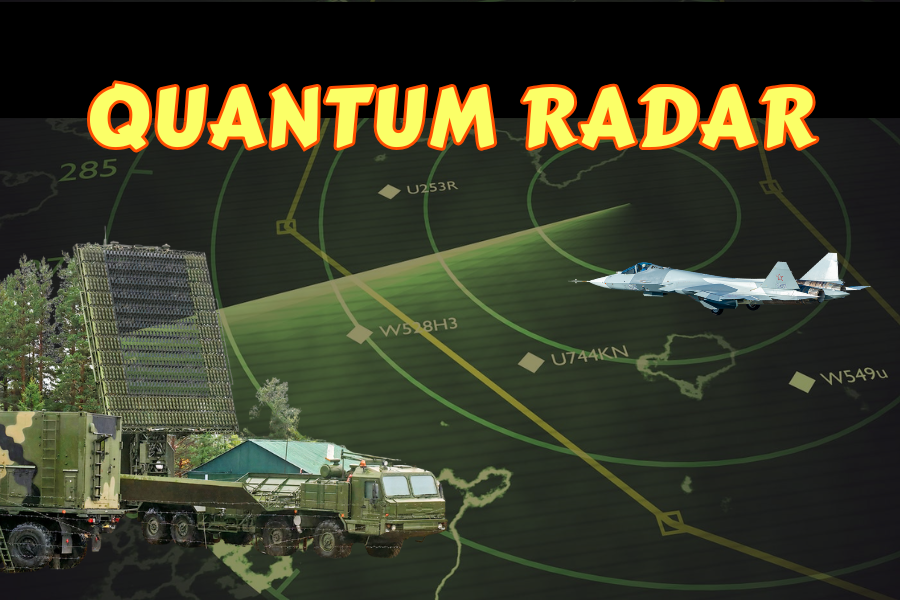(Lt Col Khalid Masood)
In the escalating race for military supremacy, quantum radar emerges as a disruptive technology poised to redefine the battlefield. Unlike conventional radar systems that rely on radio waves, quantum radar harnesses the enigmatic properties of quantum mechanics—specifically, entangled photons—to detect stealth aircraft, drones, and camouflaged targets with unprecedented precision. By exploiting the phenomenon of quantum entanglement, where paired particles remain interconnected across vast distances, quantum radar promises to neutralize the advantages of stealth technology, resist jamming, and operate covertly. While still in the experimental phase, its development by global powers like China and Western nations signals a transformative shift in defence surveillance. This article explores quantum radar’s principles, potential, challenges, and geopolitical implications, offering a Pakistani perspective on its role in countering India’s military ambitions.
1. The Science of Quantum Radar: Entangled Photons as Stealth Detectors
Traditional radar systems emit radio waves that reflect off targets and return to a receiver, revealing location, speed, and size. Stealth aircraft, such as the US F-35 or India’s AMCA prototype, are designed to absorb or deflect these waves, rendering them nearly invisible to conventional radar. Quantum radar, however, operates on a fundamentally different principle: quantum illumination, which leverages entangled photon pairs.
How It Works
- Entangled Photons: A quantum radar generates pairs of entangled photons—signal and idler—using techniques like parametric down-conversion, where a photon is split by a non-linear crystal. The signal photon is transmitted toward a target, while the idler remains at the radar base.
- Quantum Correlation: When the signal photon interacts with a target, its quantum state changes (e.g., phase or polarisation). Due to entanglement, this change is mirrored in the idler photon, allowing the radar to detect the target’s presence, even if few signal photons return.
- Noise Immunity: Quantum radar excels in noisy environments. By comparing the returning signal photon with its idler twin, the system filters out background noise (e.g., thermal radiation or solar flares), achieving a superior signal-to-noise ratio compared to classical radar.
- Stealth Detection: Stealth aircraft reduce radar returns significantly, but quantum radar can detect even a handful of returning entangled photons, making stealth technology less effective.
This “spooky action at a distance,” as Einstein described entanglement, enables quantum radar to identify low-observable targets without relying on high-energy emissions, offering a covert and jam-proof alternative to traditional systems.
2. Global Development: China and the West in the Quantum Race
Quantum radar is no longer science fiction. Both China and Western nations are investing heavily, with prototypes demonstrating real-world potential.
China’s Advances
- China Electronics Technology Group Corporation (CETC) has developed a quantum radar capable of detecting targets at significant ranges, showcasing a prototype that tracks stealth aircraft and resists jamming. Plans to deploy quantum radar on high-altitude platforms like blimps or UAVs aim to target ballistic missiles, stealth planes, and spy satellites. Enhanced single-photon detectors have improved its range and reliability.
- Chinese researchers claim quantum radar could reveal detailed target characteristics—shape, speed, and material composition—making it immune to spoofing or decoys.
Western Efforts
- Researchers in Canada have developed a quantum-enhanced noise radar, detecting targets more effectively than classical radar in noisy conditions. A multi-million-dollar project aims to field-test this technology, replacing ageing Arctic radar stations.
- Austria demonstrated a microwave quantum radar using entangled photons, validating short-range detection.
- The US, through DARPA and Lockheed Martin, is exploring quantum radar, with research focused on countering stealth, though details remain classified.
3. Strategic Implications: A Stealth-Breaker with Pakistani Relevance
Quantum radar’s potential to neutralise stealth technology could upend military balances, particularly in South Asia, where India’s stealth ambitions challenge Pakistan’s air defences.
Military Advantages
- Stealth Neutralisation: By detecting stealth aircraft like India’s Rafales or future AMCA, quantum radar could render India’s costly stealth investments obsolete. This aligns with Pakistan’s need to counter India’s numerical air superiority.
- Jam-Proof Operation: Unlike classical radar, quantum radar resists jamming, as any interference disrupts entanglement, alerting the system. This is critical against India’s electronic warfare capabilities.
- Covert Detection: Quantum radar’s low-energy emissions make it hard to detect, enabling Pakistan to monitor Indian airspace discreetly.
- Target Identification: Detailed imaging could distinguish decoys from real threats, countering India’s missile and drone tactics.
Pakistani Perspective
Pakistan’s air defences, bolstered by JF-17 Block III jets and Chinese HQ-9 systems, rely on conventional radar vulnerable to India’s stealth and jamming. Acquiring or developing quantum radar—potentially through Chinese collaboration—could level the playing field. The PAF’s May 7, 2025, downing of six IAF jets, including 3-4 Rafales, exposed India’s vulnerabilities. Quantum radar could enhance such victories by detecting stealth assets like F-35 or SU-57 early, enabling precise missile engagements. Pakistani defence experts urge the Government to invest in quantum technologies, citing China’s advances.
Geopolitical Risks
- Arms Race: China’s lead in quantum radar could pressure India to accelerate its own programmes, escalating tensions. Pakistan must navigate this race to avoid being outpaced.
- Global Alliances: US and Canadian advancements may limit Pakistan’s access to Western quantum tech, necessitating deeper Sino-Pak ties.
- Nuclear Deterrence: By exposing stealth delivery systems, quantum radar strengthens Pakistan’s nuclear second-strike capability, reinforcing deterrence against India.
4. Challenges and Limitations
Despite its promise, quantum radar faces significant hurdles:
- Decoherence: Entanglement degrades over distance due to environmental noise, limiting range.
- Range and Resolution: Current prototypes detect presence but struggle with shape or distance, critical for targeting.
- Technical Complexity: Generating and detecting entangled photons requires cryogenic conditions, impractical for battlefield deployment.
- Countermeasures: Advanced classical radars (e.g., passive or bi-static) and non-radar methods (infrared, acoustic) may still challenge stealth, reducing quantum radar’s unique value.
- Cost and Scalability: High costs and size constraints hinder integration into mobile platforms like fighters or UAVs.
Skeptics argue that decoherence and engineering challenges make operational quantum radar a distant prospect.
5. The Future: From Sci-Fi to Reality
Quantum radar is transitioning from laboratories to potential deployment. Key advancements include:
- Single-Photon Detectors: Improved efficiency in capturing returning photons.
- Microwave Entanglement: Research shows progress in practical microwave-based systems.
- Platform Integration: China’s stratospheric deployment plans suggest scalable applications.
For Pakistan, partnering with China could accelerate access. However, Pakistan must invest in indigenous quantum research to avoid dependency, as urged by numerous defence analysts.
6. Conclusion: A Game-Changer in Waiting
Quantum radar, with its ability to pierce stealth, resist jamming, and operate covertly, is a potential game-changer in military surveillance. Its use of entangled photons to outwit conventional defences aligns with the vision of a “stealth-breaker no one saw coming.” For Pakistan, facing India’s growing stealth capabilities, quantum radar offers a strategic equalizer, enhancing air defence and deterrence. Yet, challenges like decoherence and cost demand cautious optimism. As China and the West race toward operational systems, Pakistan must align with allies and invest in quantum innovation to secure its skies. In the words of Quaid-e-Azam Muhammad Ali Jinnah, “With Unit, Faith and Discipline, there is nothing worthwhile that you cannot achieve.”







